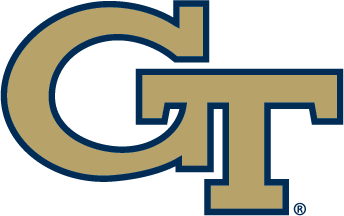Sept. 22, 2016
Georgia Institute of Technology has named former Tech football player and Oregon State University Athletic Director Todd Stansbury as its new director of athletics. The 1984 alumnus (B.S. Industrial Management) was introduced at a Thursday morning press conference by Georgia Tech President G.P. “Bud” Peterson.
Stansbury has served as Oregon State’s athletic director since June 2015 following a nine-year stint as the university’s executive associate athletic director from 2003-2012. During his time at Oregon State, Stansbury was part of a senior management team that raised $150 million for a football stadium expansion, in addition to fundraising for the construction of a sports performing center. He also was part of a team that established several career development initiatives for student-athletes.
“Todd Stansbury is committed to athletes’ success both on and off the field,” Peterson said. “His global perspective and leadership experience in athletics and development, combined with a lifelong passion for Georgia Tech, make him the ideal candidate. I believe this is one of those rare golden moments in life where opportunity meets ambition. We welcome him home.”
Stansbury’s resume also includes roles as athletic director at the University of Central Florida (2012-2015) and East Tennessee State University (2000-2003). He was Georgia Tech’s assistant athletic director for academics from 1988-1995 under Homer Rice. Now he returns to campus to guide a department that features 15 teams in 17 NCAA Division I varsity sports. He will be introduced during tonight’s home football game against Clemson.
“I am honored and humbled to have the opportunity to return to Georgia Tech, a place that has played such a large role in my life and the place responsible for opening up a world to me that I didn’t even know existed,” Stansbury said. “I am thankful to President Peterson and the selection committee for providing me this opportunity.”
Stansbury grew up in Canada. When he was 10 years old and on vacation with his family in Florida, he befriended several Georgia Tech football players staying at the same hotel. During the drive back home to Ontario, his family stopped on campus to see a practice. That’s when Stansbury knew he wanted to play football on The Flats. He earned varsity letters while at Georgia Tech from 1980-1984 as a middle linebacker and on special teams for head coach Bill Curry. He was a third-round draft pick of the Canadian Football League’s Saskatchewan Roughriders in 1984.
Stansbury is only the ninth director of athletics in Georgia Tech history. He will follow in the footsteps of storied names such as Rice, John Heisman, and Bobby Dodd. He was hired following a national search that began in August when Mike Bobinski accepted the athletics director position at Purdue University. A nine-member search committee led by Georgia Tech Foundation President Al Trujillo identified candidates. The search process was assisted by Turnkey Search.
Paul Griffin, who is serving as interim director of athletics, will assist with the transition through the end of the year.
“I want to thank Al and the search committee for their outstanding guidance in evaluating candidates,” Peterson said. “I’m also personally grateful for the leadership and Paul, who interrupted his retirement to return to campus to lead our Athletics Association. He will continue to be a great asset during the transition period for the remainder of 2016.”
Georgia Tech has achieved a school-record Graduation Success Rate (84 percent according to the most recent NCAA figures from November 2015) in each of the past three years. The Institute also recorded outstanding scores in the Academic Progress Rate (APR), which provides a real-time NCAA metric to measure the success of institutions in moving student-athletes toward graduation. The latest APR statistics, released in April, reported that 13 of Georgia Tech’s 15 teams scored 980 or better out of a possible 1,000 points.
Meet Todd Stansbury
- Age: 55
- Wife: Karen
- Hometown: Oakville, Ontario
- Education:
- Georgia Tech (B.S. Industrial Management, 1984)
- Georgia State (M.S. Sports Administration, 1993)
- Work History:
- 2015-2016: Oregon State Univ. Vice President/Director of Athletics
- 2012-2015: Univ. of Central Florida Vice President/Director of Athletics
- 2003-2012: Oregon State Univ. Executive Associate Athletic Director
- 2000-2003: East Tennessee State Univ. Director of Athletics
- 1997-2000: Univ. of Houston Associate Athletic Director (was also an adjunct professor)
- 1996-1997: Southern Network Services — Manager, Internet Business Services
- 1995-1996: Institute for International Sport — International Coordinator
- 1988-1995: Georgia Tech Assistant Athletic Director for Academics
- 1986-1987: Citizens & Southern National Bank — Credit Manager
_________________________________________________________________________________
Introductory Press Conference (Sept. 22, 2016)
Audio Only below:
Meet our new director of athletics Todd Stansbury #TogetherWeSwarm pic.twitter.com/loxKYcj5BM
— Georgia Tech Sports (@GTAthletics) September 22, 2016
Dr. Bud Peterson Opening Statement:
We welcome you here this morning, as following a national search Georgia Tech has selected a new Athletic Director. He’s a seasoned leader, a Georgia Tech alum and a former student-athlete. Todd Stansbury comes to Georgia Tech after having served as the Athletic Director at Oregon State for the past year and as their Executive Associate Athletic Director for nine years. He also served as the Athletic Director at both the University of Central Florida and East Tennessee State University. Todd Stansbury is a man who is committed to the success of student-athletes both on and off the field. He was mentored by the best. He was a Georgia Tech Assistant Athletic Director for Academics from 1988-95 under Dr. Homer Rice who developed Georgia Tech’s Total Person Program, a program that was designed to help student-athletes achieve their full potential in all areas of their lives. It’s a program that is still in use today. Throughout his career Todd has developed student leadership programs that emulate the Total Person Program created here at Georgia Tech. This program, along with the support of our coaches and athletics staff, has resulted in student-athletes who not only successfully complete their education, but also give back to their community. I continue to be impressed with not only their success in the athletic arena, but with their success in the academic arena. Todd now returns to campus to guide a department that features teams in 17 NCAA Division I varsity sports. I anticipate that Todd will start sometime in late November or early December of this year. Until then, Paul Griffin will continue to serve as the Interim Director of Athletics and afterwards will assist Todd in the transition. I want to take this opportunity to thank Paul Griffin for agreeing to be Georgia Tech’s Interim Athletic Director for the second time. He’ll continue as an invaluable asset during this transition. I also want to extend a special thanks to the athletics staff, this is an unexpected additional burden this morning with a football game tonight. I appreciate all of your efforts to help make this possible. And finally, I want to thank Al Trujillo and the other members of the search committee for their outstanding guidance in evaluating candidates. The search committee early on quickly identified the key characteristics that they thought we should look for in an athletics director. This included someone who had a true passion for Georgia Tech and Todd Stansbury not only has that passion for his alma mater, but I believe will inspire that passion in our student-athletes, our coaches, our alumni and all of the folks here in Georgia. In many ways Todd is returning home. He earned his Bachelor of Science in Industrial Management in 1984, but his affiliation with Georgia Tech started much earlier. He actually saw his first Georgia Tech football practice at 10 years old when he and his family stopped on campus while driving through Atlanta on vacation. That, he tells me, is when he first knew that he wanted to play football at Georgia Tech. He lettered as linebacker and special team’s player while at Georgia Tech from 1980-84 for head coach Bill Curry. He was a third-round draft pick of the Canadian Football League’s Saskatchewan Roughriders in 1984. His financial background is a tremendous resource. At Oregon State he was part of the senior management team that raised $150 million for a football stadium expansion and construction of a sports performing center, as well as developing several career development initiatives for student-athletes that again emulated the Total Person Program. His global perspective, his leadership experience in athletics and development combined with his lifelong passion for Georgia Tech make him the ideal candidate. I believe that this is one of those rare golden moments in life where opportunity meets ambition and we welcome Todd Stansbury home.
Todd Stansbury Opening Statement:
Well, this is a little surreal. First of all, I would like to thank Dr. Peterson and the committee for giving me this great opportunity and bringing me home. I’ve done a number of these in the past, but you might have to bear with me through this because this is more than just another AD job. As Dr. Peterson stated, my journey to this point started a long time ago. It’s been 45 years since I first decided when I was going to come to Georgia Tech, which is an interesting story considering at the time I was playing hockey up and Oakville, Ontario, but before I kind of get into those kind of comments I would like to thank some people. First of all I would like to thank my wife Karen, who’s crisscrossed the country with me a number of times in pursuit of this dream, this one right here. (She) has literally been my partner as we’ve travelled around the world, which I know some of you know that the only reason we ever left Georgia Tech was because we were crazy enough to backpack around the world for two years. My parents are here, Marlene and Julio Yustin. They allowed me to believe in some pretty crazy dreams and never got in the way, and the fact that I was a 10 year old hockey player from Oakville and had decided that I was going to play football at Georgia Tech, they never got in the way or tempered that dream of mine despite the fact that many of their friends and other people in our family basically told them they should because I’ll only be disappointed. So I appreciate not only the support, but just allowing me to dream some pretty crazy dreams that a lot of them have actually come true. I would like to thank my mother-in-law Bea Hammond who is here from Greenville, S.C. and I think is pretty excited about the game tonight. And I think about her daughter coming home and I think she is pretty excited about Georgia Tech as well. I’d like to thank Bill Curry for showing me what `The Tech Way’ was and at the time of course you’re only 18 years old and you think that this is the way they do it everywhere and then once you leave you find out that this isn’t the way they do it everywhere. There is a Tech way and it’s the right way. For the last 20 years that I’ve been away from The Flats, I’ve done everything I could to bring `The Tech Way’ to every place I’ve been. I want to thank Homer Rice for having the vision in the early 80’s before anybody had any concern about student-athlete welfare or developing young people through athletics, and he was a true visionary. I was a freshman his first year here, so the irony is I went through the first class of the Total Person Program. At UCF and at Oregon State we call it the Everyday Champions Program, but it’s basically the evolution of everything that I learned while I was here. In fact my whole career everything that I’ve done, every program that I’ve led, the DNA can be found here on The Flats. This place had a profound impact on my life, it changed my life and I think for that I have to thank my friend, my mentor – some of you know him as Captain Crazy, Big Z, he goes by a number of different names – but Scott Zolke is the young quarterback that I met on the beach in Daytona when he was a sophomore here and I was a 10 year old kid in Canada. And because he played attention to me and was nice to me, that’s where the dream came from and now we’ve been friends for 45 years and I owe him almost everything because the day I met him was one of those life defining moments where there is a fork in the road and this fork brought me here. I want to thank the faculty members of Georgia Tech because they pushed me and showed me potential that I had that I didn’t even know what I could become. Specifically, I would like to thank Dr. Phil Adler, who had an incredible impact on me. The fact that I took him for seven classes when most people can’t survive one tells you a lot about how I felt about Phil Adler. Fred Allvine, Bob Green, the faculty of the College of Management really pushed me and would not … it was the Tech way – it wasn’t easy, but that’s part of it. And I think that’s where the true value of what we learn here is, that if it’s worth it you’re typically going to have to work for it. I learned a lot while I was here. I’ve done everything that I could to take what I learned here to other places and be the evangelist of the Georgia Tech way and what I’ve found in my whole philosophy on intercollege athletics really is rooted in my own experience. Because I wanted to play a game, the faculty and coaches here were able to push me and really help me find potential that I didn’t even know I had and that’s what athletics does. At a time when zip code is the major indicator of access to college and success in college, athletics cast a wide net where we don’t care what the zip code is. What I learned is because we just want to play a game, because these young people just want to play a game, they’ll do anything we ask them to do. And so it is up to us to ask them. Because all things equally you pick a student-athlete every time and it is up to us to make them equal. So, Homer Rice had the Total Person Program. I’ve got the Everyday Champions Program. I have a feeling it is going to revert back to the Total Person Program, but that program is so much more than just a bunch of programs and bringing in speakers and it is where the student-athlete, one, finds that you actually care about them because it is more than just what they’re going to do on the field or what you see across the ticker, or even what they do in the classroom. I think the other thing about it is that makes it so incredibly important and Tech found this out a long, long time ago, is that graduation is the beginning of the journey not the end. And so our focus will be on the success of our student-athletes and of course they’re going to graduate, but it’s what are they doing five and 10 years after graduation. If you look at what Georgia Tech graduates are doing five and 10 years after graduation that is our differentiator. That is what sets us apart and that needs to be part of our brand. I am so incredibly thankful to be back. This is home. This is where I found who I was and it provided me a launch pad that so far been a pretty good adventure and to be back here and be able to finish my career where it started is just an incredible gift. Again, I would like to thank Dr. Peterson for making that possible. Thank you.
How much work did the search committee have to do since it appears that you (Todd) were pretty much setup for the job?
Dr. Peterson – Well actually the search committee, the first thing they did, Al pulled the search committee together I think within a week of Mike’s announcement of his resignation, and the first thing they did was outline the characteristics of what we were seeking in an athletic director. They met a number of times, reviewed the candidates, provided advice and guidance, so they played an integral part in the process. As you might imagine, this has moved pretty quickly. These searches get a lot of attention and so you try to do things as quietly as possible. But we’re indebted to the search committee for their efforts. We found an athletic director that fulfills all of the characteristics that they identified.
First, can you describe the timeline of how this all came about?
Todd – Well it all happened pretty quickly. Probably it all came about in I’d say last 72 hours.
Within those 72 hours, what were the steps that got you to eventually get you to say `I’ll do the job’?
Dr. Peterson – Well we met with a number of candidates. Interviewed a number of candidates and I asked Todd if he wanted the job and he said yes. He said yes and I said, `we’ll figure it out from there.’ And we have. I think we’re in a great place. I’m very pleased. I didn’t have to twist his arm.
While you were working at OSU and then you hear about the Tech opening, was there ever a point, prior to being contacted by Dr. Peterson that you thought you’d like to be at Tech?
Todd – Are you serious? Let’s just say because I was on the West coast, when it became public that Georgia Tech was going to be looking for a new athletic director, around 3:30 in the morning, 4 in the morning, my phone just started blowing up and I thought that somebody had either died or somebody was in trouble. And of course, it was that the Georgia Tech job was open. So knowing that this has always been the goal, was to eventually come back to the Flats, I was hoping that this could potentially be a possibility. But of course it was tempered because I was in a great spot. I have a great staff and we were doing some really, really innovative things. It was one of those that I thought that this opportunity may present itself and was hoping that it might, but never knew for sure.
Dr. Peterson – I will just add that Gene DeFilipo was the search consultant that we used and he and his firm at Turnkey did a great job in helping identify candidates, bring those candidates in, get them together and move this process forward. I was very pleased with Gene and his company.
Todd, you just spoke about some of the innovative things that you were doing at Oregon State. What are some of the things you plan on bringing here to Georgia Tech?
Todd – Kind of in my evolution of the Total Person Program and the creation of the Everyday Champions Program, we started to look at that, not only as obviously a support program for student-athletes, but it being central to our business. In that, started to create revenue producing programs. One of them is called the First Round Draft Choice Program. It’s a program where we do corporate partnerships, but they’re not your traditional corporate partnership. They’re not a marketing partnership, they’re an HR partnership. By being a partner, you’re actually engaged in the programming of the Everyday Champions Program. In exchange to that, you have access to the best talent. Your executives are engaged in not only making sure that we’re developing the skills in our student-athletes that they say they want, we use the junior achievement model where their executives are actually teaching the students. And that way, over four years, you’re going to know who their first round draft choices are. It’s something we started at UCF and continued to evolve at Oregon State and that’s something that I think would work perfectly in Atlanta, Georgia just looking at the skyline. I know there’s a lot of potential partners that I think would be interested in the talent that we’re producing.
We’ve heard a lot of talk about Georgia Tech trying to keep up the Jones in terms facilities, staffs and programs like Clemson, Georgia, etc. Will that be one of the issues that you’ll be addressing?
Todd – I think that it is important that your facilities are in sync with other facilities at your competitors. But I think it’s also important that you’re true to yourself and who you are. Of course, I’m coming from a place that is 45 miles from Eugene, Oregon – totally different culture. So I think what’s really important is understanding who you are, what fits you in making sure that you’re providing the best facilities for your coaches and student-athletes so that they can be successful. But that doesn’t necessarily mean that you need a waterfall in your locker room. And I think that those are the things that are important when you assess what you need as you identify what you need and what fits you and that’s what I’ve done at both Oregon State and UCF and will continue to do that here.
When you were back at Oregon State, I think I read that since you knew the place, it didn’t take long to get up and running. Do you think that at all here or do you think you’ll need some time to learn the landscape?
Todd – It’s going to be a little bit different because I’ve been gone for 20 years and a lot has changed. But the DNA hasn’t. So I think my advantage here is going to be just understanding the culture of the Institute. I’m not going to just assume that because I’ve got a Georgia Tech degree on my wall, that I know exactly what’s going on. I’ll still have to do your typical new AD due diligence in trying to find out what is going on and ask of a lot of questions and try not to make any really stupid rash decisions because you think you know everything. But I hope that because I understand the culture and I recognize a lot of the faces, even though they’ve got a lot less hair and are a little grayer, that I’ll hopefully be able to get up and running fairly quickly.
For the latest information on the Georgia Tech Yellow Jackets, follow us on Twitter (@GTAthletics), Facebook, Instagram or visit us at www.ramblinwreck.com.









